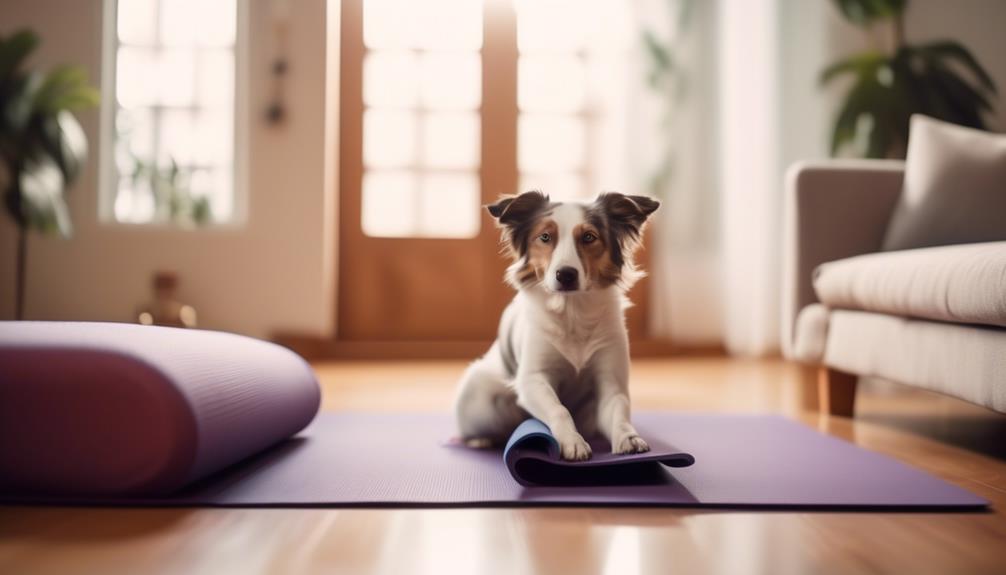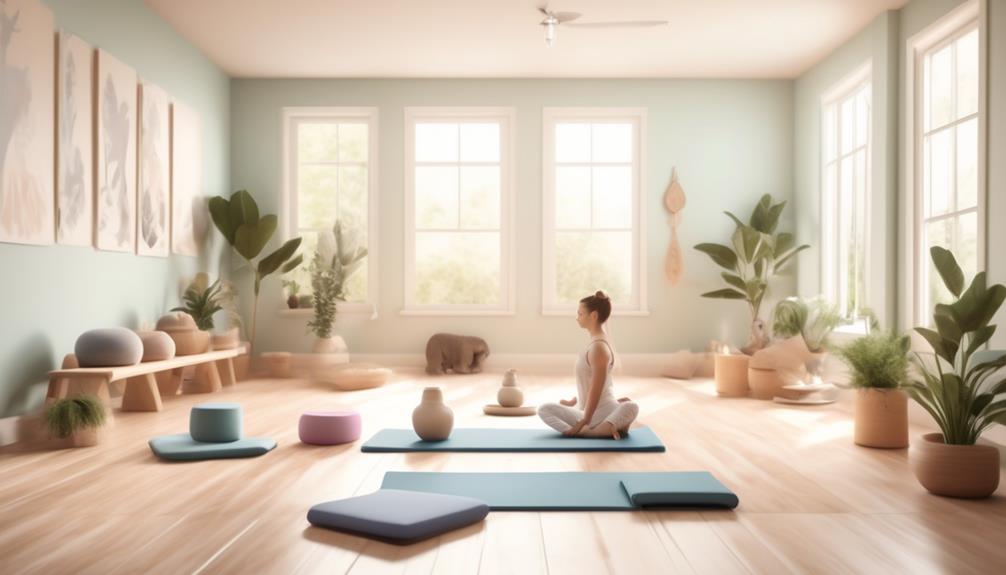How to Encourage Reluctant Pets to Try Yoga

Effective strategies and techniques to encourage reluctant pets to try yoga include:
- Understanding their fears and anxieties
- Being patient with their progress
- Using positive reinforcement
- Creating an enticing environment that makes them curious about yoga.
Understanding their fears and anxieties is crucial in helping reluctant pets try yoga. By identifying what specifically makes them uncomfortable, such as certain poses or unfamiliar surroundings, you can tailor your approach to gradually introduce them to these elements and help them overcome their fears.
Being patient with their progress is essential. Just like humans, pets need time to adjust to new activities. Pushing them too hard or expecting immediate results can cause them to become even more resistant. Slowly introducing them to yoga, starting with simple and gentle poses, will allow them to build confidence and gradually become more comfortable with the practice.
Using positive reinforcement is a powerful tool in motivating pets to try yoga. Rewarding them with treats, praise, or playtime after each successful attempt at participating in a yoga session will create positive associations and encourage them to continue participating.
Creating an enticing environment that makes pets curious about yoga can also help overcome reluctance. Utilize toys, props, or scents that they find interesting or enjoyable during yoga sessions. This will pique their curiosity and make them more likely to engage in the practice.
By implementing these strategies and techniques, pet owners can gradually encourage their reluctant pets to try yoga and potentially reap the numerous benefits it offers.
Key Takeaways
- Understanding and addressing pets’ fears and anxieties is crucial in encouraging them to try yoga.
- Creating a calm and inviting environment with soft lighting, calming scents, familiar objects, and soothing elements can help pets feel more comfortable.
- Introducing yoga poses gradually, starting with gentle stretching techniques and easing into poses like Child’s Pose, Cat-Cow Stretch, and Downward Dog, can help pets ease into the practice.
- Using treats and positive reinforcement, such as treat rewards and association with positive experiences, can motivate pets to participate in yoga and build trust and bonding.
Understanding Your Pet’s Resistance
Understanding why your pet may be resistant to trying yoga can help you approach their hesitation with empathy and patience. Just like humans, pets may have their own reasons for resisting this new activity.
One common reason for resistance is fear of the unknown. Animals are creatures of habit, and introducing a new practice like yoga can disrupt their routine, making them feel uncomfortable and unsure.
Another possible reason is physical limitations. Certain pets may have health issues or age-related conditions that make it difficult for them to participate in yoga poses. It’s important to be mindful of any potential discomfort or pain your pet may experience.
Additionally, some pets may simply be uninterested in yoga. They may prefer other activities or have different ways of relaxing. It’s crucial to respect their preferences and not force them into something they don’t enjoy.
Overcoming these obstacles requires patience, understanding, and flexibility. By slowly introducing yoga in a gentle and positive manner, your pet may gradually become more open to trying it. Providing a comfortable and safe environment, using positive reinforcement, and seeking guidance from a professional can also help in overcoming resistance.
Creating a Calm and Inviting Environment

To create a calm and inviting environment for your reluctant pet to try yoga, it’s important to set the stage with soothing elements and familiar surroundings. Here are three ways you can create a calming atmosphere and set up a designated yoga space for your pet:
- Soft lighting: Use warm, dim lighting to create a serene ambiance. This will help your pet feel more relaxed and comfortable during yoga sessions. Avoid harsh, bright lights that may cause anxiety.
- Calming scents: Incorporate aromatherapy into your pet’s yoga experience. Choose scents like lavender or chamomile, known for their calming properties. You can use essential oils or scented candles to create a soothing atmosphere.
- Familiar objects: Place your pet’s favorite blanket or toy near the yoga space. Familiar objects can provide a sense of security and help your pet feel more at ease. This will make them more likely to engage in yoga activities.
Introducing Yoga Poses Gradually

Introducing yoga poses gradually is crucial when it comes to encouraging reluctant pets to try yoga.
Gentle stretching techniques can help ease them into the practice, allowing their muscles to become more flexible over time.
Gentle Stretching Techniques
Gently easing your reluctant pet into yoga poses can be a rewarding and effective way to introduce them to the practice. Here are three gentle stretching techniques that can help relax your pet and strengthen the bond between you:
- Child’s Pose: Begin by sitting on the floor with your legs folded underneath you. Encourage your pet to lie down in front of you, and gently place your hands on their back, applying gentle pressure to encourage a stretch. Hold this position for a few breaths, allowing your pet to relax and release tension.
- Cat-Cow Stretch: Start on all fours, with your pet beside you. As you inhale, arch your back and lift your head, mimicking a cat stretching. As you exhale, round your back and tuck your chin, imitating a cow. Encourage your pet to join in, moving their body in sync with yours.
- Downward Dog: Begin in a plank position, with your pet standing beside you. Slowly lift your hips and straighten your legs, forming an upside-down V shape. Encourage your pet to follow suit, stretching their body and lengthening their spine.
Remember to be patient and understanding with your pet during these gentle stretching exercises. Gradually introducing them to yoga poses will help them feel more comfortable and open to trying new movements.
Slow Introduction to Poses
When introducing yoga poses to your reluctant pet, it’s important to take a slow and gradual approach. Start with simple poses that your pet can easily follow, such as the downward dog or the cat-cow stretch. Allow your pet to observe and imitate you, gently guiding them into the correct positions. Remember to be patient and give your pet plenty of time to adjust to each pose.
As you progress, incorporate relaxation techniques, such as deep breathing and gentle massage, to help your pet feel more comfortable and at ease. This slow introduction to poses not only promotes physical flexibility and strength but also fosters a deeper bond between you and your pet.
Using Treats and Positive Reinforcement

When it comes to encouraging reluctant pets to try yoga, using treats and positive reinforcement can be highly effective.
Offering treat rewards for motivation can help entice pets to participate in yoga sessions, as they associate the activity with something enjoyable.
Additionally, employing positive reinforcement techniques, such as praise and petting, can further encourage pets to engage in yoga and build a positive association with the practice.
Treat Rewards for Motivation
Positive reinforcement through the use of treats can be an effective and motivating tool for encouraging reluctant pets to try yoga. Here are three reasons why treat rewards can help pets overcome their hesitation:
- Instant gratification: Offering treats as a reward immediately after completing a yoga pose provides instant gratification for pets, reinforcing their positive behavior and encouraging them to continue practicing.
- Association with positive experiences: By associating treats with the practice of yoga, pets begin to view it as a fun and rewarding activity. This positive association helps to overcome any initial reluctance and builds enthusiasm for future yoga sessions.
- Building trust and bonding: Using treats as a form of positive reinforcement strengthens the bond between pets and their owners. It creates a sense of trust and cooperation, making pets more willing to try new experiences like yoga.
Positive Reinforcement Techniques
Using treats and positive reinforcement is a highly effective method for encouraging reluctant pets to try yoga. Understanding body language and building trust are crucial elements in this process.
When introducing yoga to a hesitant pet, it’s important to observe their body language and take cues on their comfort level. Start slowly and reward any positive response with a treat and verbal praise. This will help the pet associate the practice of yoga with positive experiences.
Gradually increase the difficulty of the poses while continuing to provide treats and positive reinforcement. By doing so, the pet will begin to trust the process and feel more confident in participating.
Encouraging With Rewards
Encouraging reluctant pets to try yoga can be made easier by incorporating rewards such as treats and positive reinforcement. Offering these incentives can help motivate pets to participate in yoga sessions and make the experience more enjoyable for them.
Here are three effective ways to use rewards and alternative motivators:
- Treats: Using small, tasty treats as rewards can encourage pets to engage in yoga poses. By associating the practice with something positive, pets are more likely to be receptive and willing to try different movements.
- Positive reinforcement: Praising and rewarding pets with verbal affirmations, gentle petting, and belly rubs can reinforce their progress during yoga sessions. This positive feedback helps create a supportive and nurturing environment, making pets feel confident and appreciated.
- Alternative motivators: Some pets may not be motivated by treats alone. In such cases, finding alternative rewards that appeal to their individual preferences can be helpful. This could include using their favorite toys, playtime, or even extra cuddles as incentives for participating in yoga.
Incorporating Pet-Friendly Props and Equipment

To create a comfortable and engaging yoga experience for your reluctant pet, incorporating pet-friendly props and equipment can make a world of difference. Just like humans, pets can benefit from the use of props to help with balance, support, and alignment during yoga practice.
Pet friendly props such as yoga mats, blocks, and blankets can provide a sense of familiarity and stability for your furry friend. Yoga mats designed specifically for pets are a great investment. These mats are usually made with materials that are comfortable for pets to lie on, while also providing enough grip to prevent slipping. Offering your pet their own designated space on the mat can help them feel more secure and willing to participate.
Blocks can be used to modify poses for pets who may have limited flexibility or mobility. Placing a block underneath their paws during poses such as Downward Facing Dog can help alleviate pressure on their joints and make the pose more accessible. Blankets can also be used to provide extra cushioning and support for pets during seated or lying poses.
Remember to always choose props and equipment that are safe and suitable for your pet’s size and breed. Introduce them gradually and observe their comfort level during the practice. With the right pet-friendly props and modifications, you can create a yoga experience that’s enjoyable and beneficial for your reluctant pet.
Practicing Patience and Consistency

After setting up a comfortable space with pet-friendly props and equipment, the next step in encouraging your reluctant pet to try yoga is practicing patience and consistency. It’s important to remember that pets, like humans, may take time to adjust to new activities. By practicing mindfulness and building trust, you can create a positive experience for your furry friend.
Here are three key elements to consider:
- Be patient: Just as you may encounter challenges when starting a new activity, your pet may also find yoga intimidating at first. Allow them to explore the space and take their time to feel comfortable. Avoid rushing or forcing them into poses. Instead, focus on creating a calm and relaxed environment where they feel safe to explore and participate at their own pace.
- Consistency is key: Incorporate short yoga sessions into your pet’s routine regularly. Consistency helps them become familiar with the practice and builds their confidence over time. Start with simple poses and gradually introduce more challenging ones as they become more comfortable. By practicing yoga consistently, you’ll establish a routine that your pet can rely on and look forward to.
- Offer rewards and praise: Positive reinforcement is essential in encouraging your pet to try yoga. Reward them with treats or verbal praise when they show interest or attempt a pose. This positive association will motivate them to continue their yoga practice and strengthen the bond between you and your pet.
Seeking Professional Guidance and Support

If you find that your pet is still hesitant to try yoga, seeking professional guidance and support can be a valuable resource. Professional trainers who specialize in working with animals can provide the expertise and knowledge needed to overcome your pet’s fear and reluctance. These professionals have undergone extensive training and have experience with various techniques and methods to help animals feel comfortable and confident during yoga sessions.
A professional trainer can assess your pet’s individual needs and tailor a training program specifically for them. They can provide guidance on how to introduce yoga poses gradually, using positive reinforcement techniques to build trust and reduce anxiety. Additionally, they can teach you how to read your pet’s body language and signals, allowing you to better understand their needs and comfort levels.
To emphasize the importance of seeking professional help, here is a table showcasing some benefits of professional training for reluctant pets:
| Benefits of Professional Training |
|---|
| Expert guidance and knowledge |
| Individualized training programs |
| Techniques to build trust and confidence |
| Understanding of pet’s body language |
| Positive reinforcement methods |
Frequently Asked Questions
Can My Pet Get Injured While Practicing Yoga?
Pets can potentially experience injuries while practicing yoga, but there are measures that can be taken to ensure their safety. By following proper techniques, using appropriate props, and starting with gentle poses, the risk of injury can be minimized.
How Long Does It Usually Take for a Reluctant Pet to Warm up to Yoga?
Encouraging a reluctant pet to try yoga can take time and patience. By introducing yoga gradually and creating a peaceful environment, pet owners can help their furry friends feel more comfortable and willing to participate.
What if My Pet Doesn’t Respond to Treats and Positive Reinforcement During Yoga Sessions?
If a pet doesn’t respond to treats and positive reinforcement during yoga sessions, alternative methods can be tried. Dealing with distractions, such as noise or other animals, may require patience and finding what motivates the pet.
Are There Any Specific Props or Equipment That Are Recommended for Pets During Yoga?
Pet friendly yoga props can greatly enhance a pet’s yoga experience. Whether it’s a comfortable mat, a soothing eye pillow, or a gentle massage brush, these props can provide comfort and support, making yoga more enjoyable for reluctant pets.
How Do I Know When It’s the Right Time to Seek Professional Guidance for My Pet’s Yoga Practice?
When it comes to seeking professional guidance for your pet’s yoga practice, it’s important to pay attention to their behavior and progress. If you notice any persistent difficulties or concerns, reaching out for professional help can ensure a safe and effective practice.









